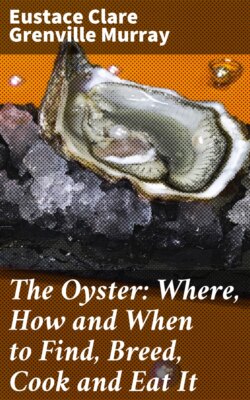Читать книгу The Oyster: Where, How and When to Find, Breed, Cook and Eat It - Eustace Clare Grenville Murray - Страница 6
На сайте Литреса книга снята с продажи.
CHAPTER III.
MODERN HISTORY OF THE OYSTER.
ОглавлениеTable of Contents
Fall of the Rutupian Supremacy; Louis IV. and William of Normandy; Conquest of England, and Revival of Oyster-eating in England; The Oyster under Legal Protection; American Oysters.
With the fall of the Empire came also the fall of the Rutupian supremacy; and even the Roman Britons, driven into Brittany and the mountains of Wales by their truculent Saxon persecutors, had to forego these luxuries of the table, unless, perhaps, Prince Arthur and his knights may now and then have opened a bushel when they were seated over their wine in that free and easy circle, which has become so celebrated as to have formed a literature of its own. From the fourth century, to which Macrobius brought us, to the reign of Louis IV. of France, the history of the oyster is a blank; but that king revived the taste for our favourite, and during his captivity in Normandy brought it again into request with his conqueror, Duke William; so, when the Normans invaded England under William the Conqueror—the descendant of that Duke William, little more than a century later—they were not long in finding out how much Kentish and Essex oysters were preferable to those of France.
Since then the Oyster has held its own against all comers, as one of the most welcome accessories to the table of rich and poor, and has been protected in his rights and immunities by various Acts of Parliament. "In the month of May oysters cast their spawn," says an old writer in the "Transactions of the Royal Society," "which the dredgers call spat, and this spawn cleaves to stones, old oyster-shells, pieces of wood, and other substances at the bottom of the sea, which is called cultch. During that month, by the law of the Admiralty Court, the dredgers have liberty to take every kind of oyster, whatsoever be its size. When they have taken them they gently raise with a knife the small brood from the cultch, and then they throw the cultch in again, to preserve the ground for the future, unless they are so newly spat, that they cannot be safely severed from the cultch, in which case they are permitted to take the stone or shell, which the spat is upon, one shell having often twenty spats. After the month of May, it is felony to carry away the cultch, and punishable to take any other oysters except those of the size of a half-crown piece, or such as when the two shells are shut will admit of a shilling to rattle between them." These brood and other oysters are carried to creeks of the sea, and thrown into the channel, which are called their beds or layers, where they grow and fatten, and in two or three years oysters of the smallest brood reach the standard size.
The property in oyster beds is defined by the 7 & 8 George IV., c. 29, s. 36, which makes it larceny for any person to steal any oyster or oyster brood from any oyster bed belonging to another person, if such bed is sufficiently marked out and known as such; and even the attempt to take either oysters or oyster brood from such an oyster bed, though none be actually disturbed, is a misdemeanor, punishable by fine or imprisonment, or both, though nothing is to prevent the fishing for floating fish within the limits of any oyster fishery.
The Admiralty Court also imposes great penalties upon those who do not destroy a fish, which they call Fivefingers (the crossfish, or common starfish of our coasts), because it is supposed that that fish gets into the oysters when they gape, and sucks them out. That it is injurious to oyster beds may be true; for its food, in part, consists of mollusks. It does not, however, walk into the oyster bodily, as the Admiralty Court suggests, but rather appears to overpower its prey by applying some poisonous secretion, and pouting out the lobes of the stomach, so as to convert them into a kind of proboscis, and thus suck the mollusks from their shells.
The reason of the penalty for destroying the cultch is that the ouse then will increase, and mussels and cockles will breed there and destroy the oysters, because they have no convenience for depositing their spat. Hence, mud and sea-weeds are extremely injurious to the "breedy creatures'" propagation and increase; for no less than starfish, cockles, and mussels, other enemies amongst shellfish and crustaceous animals, particularly crabs and scollops, eagerly devour the oyster, when they can capture it.
In America, where the quality of the native oyster, though little inferior to the larger species of Britain, is greatly over-rated, the legislature is now called upon to make a similar provision for its protection against its greatest enemy, man. "It has been estimated," says a correspondent in No. 769 of the "Family Herald," "that the State of Virginia possesses an area of about 1,680,000 acres of oyster beds, containing about 784,000,000 bushels of oysters. It is also stated that the mother oyster spawns annually at least 3,000,000; yet, notwithstanding this enormous productive power, and the vast extent of oyster beds, there is danger of the oyster being exterminated unless measures are adopted to prevent fishermen from taking them at improper seasons of the year. It is therefore proposed to have either a flotilla of four steamboats employed to protect the oyster beds from piratical intruders, or to farm out the oyster beds to private contractors to do with them as they please."
